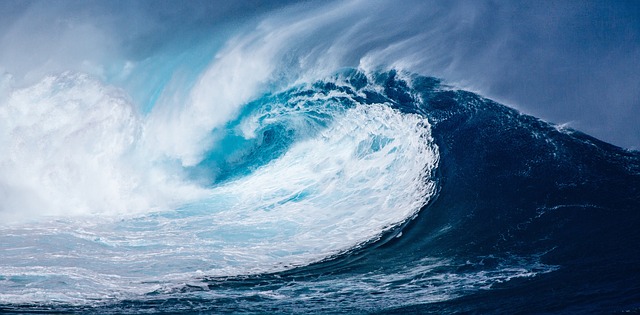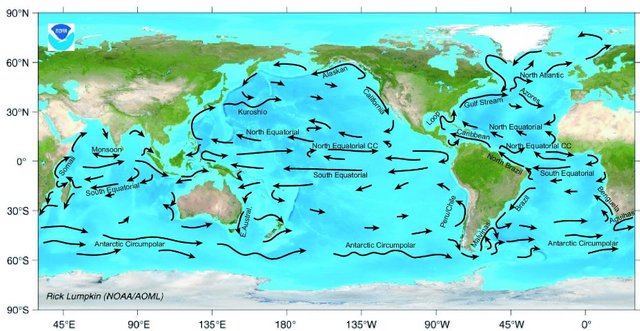Renewable energy - Part 2: Basics of Ocean Energy
Oceans... does the word remind you of something? I mean besides George Clooney's movies. This word is also related to the larger portion of water that covers the earth surface. Quick question, can you name all the oceans? I couldn't, till I was preparing this post. We have five oceans - Pacific, Indian, Atlantic, Arctic, and Antarctic. The last one being the most recently recognized ocean. Together, these cover 71% of earth's surface. Since this post is about renewable energy, allow me to introduce you to all the ways we can (at least theoretically for now) harvest energy from.
Note: The writer, just like most of you, doesn't live near an ocean. Also, I've never even travelled across one. I did see one though...lol. The series of articles I will be posting are entirely based on lectures, and books, and articles available all over the internet.
Wave Energy
This one is obvious right? Disturb a plane water surface and there are ripples. These ripples are caused by
- Water molecules in an up and down motion, and
- Transfer of energy from a molecule moving up and down to its adjacent molecules which we can see as the "travelling" of the ripple through the water surface.
A bit more detailed version would also say that these ocean waves are a result of wind blowing over the surface of the ocean, and the earthquakes and volcano eruptions that might occur sometimes under the oceans’ surface. Mostly it's just the wind at work.
Moving air molecules in the wind (kinetic energy), which strike the water molecules on the ocean surface, result in the movement in the water molecule, which further transfers it's energy to nearby molecules, ultimately resulting in a wave in the ocean (or at least a ripple). The waves can be seen as if the wind and the water are dancing together. - Poetic me...
What if someone said the rains create waves too? Because the waves are much more energetic (or simply, they rise much higher) when it is raining in the oceans, right? Of course it's right... We've watched all the fight scenes in Pirates of The Caribbean series multiple times, haven't we? But in this case too, it's still the wind that creates the waves. I'll tell you why.
The wind is a result of temperature difference between different points in the atmosphere. The more the temperature difference, the faster the wind blows, from the colder regions to the hotter regions as well as from the hotter regions to the colder ones, trying balance the temperature everywhere. When it is raining (not necessarily raining, dark clouds will do the trick since they are full of water ready to be dropped down on earth), the temperature in that part of the atmosphere drops a lot, since water absorbs heat efficiently. This causes the wind to blow faster, and its speed increases even more when it's raining than when the clouds are dark since a huge area in the atmosphere is cooler now. The faster the wind, the more energetic the air molecules, and thus more energy is acquired by the water molecules they collide with, resulting in more powerful waves.
Waves can also be caused due to earthquakes or volcanoes at the bottom of the ocean surface, in which case they could turn into natural disasters, like the tsunami.
This just an introductory post, we will talk about each way of harnessing energy in detail in consequent posts.
Tidal Energy
Anyone ever wondered why the ocean surface rises and falls? Oh! They don't show this thing in the movies... Well, this does happen, twice a day in most parts. At the coastal regions, where the oceans meet the continents, we can measure the rise and fall in the sea level. Four very simple terms are used in describing them - The higher water level is called the high tide, and the lower one is called the low tide.
When the water moves towards the coast causing a rise in the seal level at the coastal region is said to be the flood current, and when it moves away from the coastal causing a fall in sea level, we call it the ebb current.
How do tides occur?
Well, it's due to gravitational forces between the earth, the moon, and the sun, the moon being the most important factor in this case. Basically, harnessing energy from the tides is a cool way to harness energy from attraction between the earth and the moon, don't you think? Sun doesn't count as the most effective factor here since it is a lot farther away from earth than the moon is. But still, effects can be noticed when earth, moon and sun are in the same line.
This again, is a very short explanation, and hopefully one that can be easily understood. We will dive into the details in later posts. Also, it's ocean we are talking about here. So we dive into the details, not dig into them... lol.
We can utilize the energy in tides due to the rising and falling of water and also due to the filling and emptying of coastal regions that result for such tidal rise and fall, which pretty much is the same thing except tides can rise and fall all over the ocean.
Ocean Thermal Energy Conversion (OTEC)
Well, we have discussed the energy we can harness by interactions between wind and ocean, and the same in case of the gravitational pull between moon and earth. Now, we discuss harnessing the solar energy stored in the ocean.
Sun light heats up the water at the top surface of the ocean. Simply because sunlight is an excellent source of light aka photons travelling at different wavelengths. When these photons strike the water surface at the top, they impart some or all of their energy to the water molecules, which further results into heating up of water.
How do we turn this heat into energy? Well, heating up of the top ocean surface creates a temperature gradient from top to bottom in the ocean. Or simply, under the influence of the sun, the temperature of the ocean decreases as we go down towards the bottom of the ocean. One more factor that needs to be considered here is - the temperature of ocean surface decreases during night and rises during the day helping us gain a constant power producing cycle.
Ocean Currents
Ocean Currents are a result of the earth's spinning around all the time, and the wind blowing over the ocean, almost all the time. Now we are talking about harnessing energy for the spin of the earth...cool!!
Well, since ocean currents are caused by wind, they originate at some point (water starts moving) and they terminate at some point (usually near land). A lot of ocean life has evolved using the ocean currents for migration purposes. An environment friendly way would be to harness its energy at the points where these currents terminate, which wouldn’t affect their migration.
Salinity Gradient
Oceans are salty water, and rivers are sweet water. At the points where rivers meet the oceans difference in the salinity occurs in the water. The salts in the ocean try to merge uniformly in the freshly arriving river water, that's just the nature of things. All things tend to be in equilibrium. We can gain some energy from this process as well.
Marine Biomass Farming
Yes, we can produce biofuels using seaweed and algae. And as you can guess from the title, we can farm them in the ocean.
Submarine Geothermal Energy
Well, this is the last one in the list. There are volcanoes at the bottom of the ocean, and there are submarine vents at seabed ocean ridges as well. Due to the heat inside the depths of earth’s crust, water gets heated and this high temperature water rises from these vents. We just need to put a turbine in its way out before it merges with much cooler ocean water, don’t you think?
A little chitchat...
We started a talk about renewable energy in my last post. I talked about solar energy and also urged the community to post about renewable energy, especially since our future depends on it. In fact, I guess I posted a bit too late since there were already quite a few articles about solar, wind, and hydro energy. A few more great articles were posted since then and I’ve read all of them. But since most of us have already chosen a few topics to work on, I thought I should choose a different topic to talk about in here. The only remaining fields of renewable energy that are lesser posted are Ocean or Marine Energy, for which many articles aren't yet available on steemit. So I just went on for a short course on oceanography, and got myself a few books to read, and now I have a series which is no where on steemit yet... The only drawback - I’m dying to make some time for writing a post about space.
It took me a bit longer to get some things clear, but I guess it was worth it. I did get to learn something cool and oceanic after all, and now I am going to try my best that you get to learn something too. Hopefully you guys enjoyed reading it.
References:


Wow such a long post,very informative and engaging!
Thank you.
Congratulations @pratik27! You have completed some achievement on Steemit and have been rewarded with new badge(s) :
Click on any badge to view your own Board of Honor on SteemitBoard.
To support your work, I also upvoted your post!
For more information about SteemitBoard, click here
If you no longer want to receive notifications, reply to this comment with the word
STOPThe oceans have proved to be a promising source of energy. But not popular as compared to the other non-conventional sources of energy like solar energy.
Kudos! @pratik27
Solar is undoubtedly the most abundant form of energy. But harnessing it comes with a few drawbacks nonetheless. For example, it requires a lot of land to set up a solar power plant, which can otherwise be used for farming or habitation. Ocean energy in this case would serve as an alternative.
Yeah, from that angle you're very right. You have a lead on that...👍
It's quite challenging to harness ocean energy - any infrastructure built has to be very rugged to survive salt, waves and bad weather, and as the electricity is mostly needed on land it needs to be transported as well.
Many small-scale powerplants have been created, and even more have been designed, but as far as I know there are no real success stories out there, except for off-shore wind farms. Oh well, I know one small device that can be bought in boat equipment shops - a wave-powered bilge pump to remove the rain water from an open boat.
It would eventually be nice to see an article summarizing all the attempts on harnessing ocean energy.
This is a nice post, all these ways of tapping energy from the ocean is amazing. I am very interested in renewable energy. Im going to make some post soon, watchout! By the way, I will be watching out for your post about space
Man you are awesome, so nicely written and so easy to understand , you made complicated stuff so easy that even a child can understand:) following you for upcoming posts :)
Thank you @rifkan.
About the wave and the power of its was I learned at the third year of senior high, but I have forgot it by the short time. He he.
Lucky you, I never had it in my syllabus, lol.